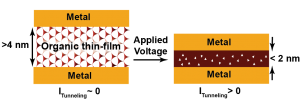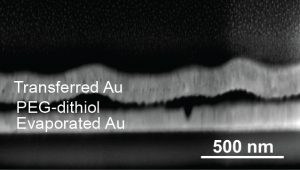Tunneling Nanoelectromechanical Switches Based on Organic Thin Films
- Category: Electronic Devices, MEMS & BioMEMS, Nanotechnology
- Tags: niroui farnaz, vladimir bulovic
With the silicon-based electronics reaching physical limits that inhibit continued improvements in device performance, much research has been directed towards nanoelectromechnical (NEM) switches as a promising alternative. NEM switches exhibit abrupt switching behavior and near-zero leakage current but suffer from large actuation voltages and failure due to stiction[1][2][3]. To overcome these challenges, this work presents a NEM switch, squitch, that operates based on electromechanical modulation of tunneling current through a nanometer-thick organic thin film (Figure 1). The switching process is initiated by the electrostatic compression of the organic film sandwiched between conductive contacts. As the organic layer is compressed, the tunneling distance is reduced, leading to an exponential increase in the tunneling current. The presence of the organic layer prevents direct contact between the electrodes. Furthermore, when the electrostatic force is removed, the deformed organic layer provides the restoring force necessary to displace the top electrode to the off-state position, helping to mitigate stiction.
Theoretical analysis of two- and three-terminal devices suggests the possibility of achieving large on-off current ratio exceeding 6 orders of magnitude, sub-1-V actuation voltage, and nanosecond switching time. Various fabrication techniques have been explored to form the metal-organic-metal junction with the organic layer created mainly through use of a self-assembled monolayer of thiolated molecules. While the bottom metallic contact is commonly formed through thermal evaporation, the top electrode can be fabricated through evaporation, nanotransfer printing of a metallic thin film, or assembly of graphene sheets. An example of a metal-organic-metal junction fabricated through nanotransfer printing of a gold (Au) top electrode is shown in Figure 2. In addition to device fabrication, our current work is focused on investigating the electromechanical response of organic-based tunneling junctions through simultaneous use of electrical and optical measurements.
- Figure 1: Schematic diagram of the squitch switching mechanism. An applied electrostatic force compresses the active organic layer, reducing the tunneling width and resulting in an exponential increase in current.
- Figure 2: Cross-sectional SEM of an example metal-organic-metal structure formed with an evaporated Au bottom electrode, self-assembled poly(ethylene glycol) dithiol organic layer, and nanotransfer printed Au top electrode.
- R. Nathanael, V. Pott, H. Kam, J. Jeon, and T. J. K. Liu, “4-terminal relay technology for complementary logic,” in Proc. IEEE Int. Electron Device Meeting Tech. Dig., Dec. 2009, pp. 223–226. [↩]
- R. Parsa, M. Shavezipur, W. S. Lee, S. Chong, D. Lee, H. S. P. Wong, R. Maboudian, and R. T. Howe, “Nanoelectromechanical relays with decoupled electrode and suspension,” IEEE 24th International Conference on Micro Electro Mechanical Systems, 2011, pp. 1361-1364. [↩]
- O. Y. Loh, and H. D. Epsinosa, “Nanoelectromechanical contact switches,” Nature Nanotechnology, vol. 7, pp. 283-295, May 2012. [↩]

